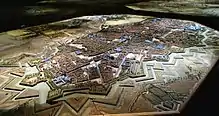Siege of Lille (1708)
The Siege of Lille (12 August – 10 December 1708) was the salient operation of the 1708 campaign season during the War of the Spanish Succession. After an obstinate defence of 120 days, the French garrison surrendered the city and citadel of Lille, commanded by Marshal Boufflers, to the forces of the Duke of Marlborough and Prince Eugene.
| Siege of Lille | |||||||
|---|---|---|---|---|---|---|---|
| Part of the War of the Spanish Succession | |||||||
_p4.220_SIEGE_OF_LILLE_-1708.jpg.webp) Siege of Lille in 1708 | |||||||
| |||||||
| Belligerents | |||||||
|
|
| ||||||
| Commanders and leaders | |||||||
|
|
| ||||||
| Strength | |||||||
|
35,000 besiegers, 120 heavy guns 80 heavy mortars 75,000 in vicinity[2] |
16,000 garrison, 159 guns 100,000 in vicinity[2] | ||||||
| Casualties and losses | |||||||
| 16,000 killed and wounded[3] |
7,000 killed and wounded 159 guns[4] 6,000 surrendered | ||||||

The siege was famous among contemporaries for l'affaire des poudres ("the gunpowder incident"), where the Chevalier de Luxembourg with 2,000 horsemen passed through the Allied lines and succeeded in delivering 40,000 pounds of desperately needed gunpowder to the defenders.[2]
The siege was made possible by the defeat of the French army at the Battle of Oudenarde and the landing in Ostend of large amounts of ammunition and food after the Battle of Wijnendale. For most of the campaign, Eugene commanded the forces besieging Lille, while Marlborough commanded the forces covering those forces against external French interference. For a short period in late September however, after Eugene was injured on the 21st, Marlborough took command of both the besiegers and the covering force.
On 22 October the Allies entered the city at the staggering cost of 12,000 casualties; Boufflers continued to resist from Lille's citadel for several weeks, exacting an additional 4,000 allied casualties.[5] While the allies' deft manoeuvring frustrated French attempts to relieve their precious fortress—the last substantial French bastion in northern Flanders—Boufflers' valiant defence likewise prolonged the siege well into winter, to the point where no operations could be undertaken against France that year.[6] The French garrison of Lille capitulated on 10 December and the remaining defenders marched out with full honours of war,[Note 1] and Boufflers was decorated by Louis XIV.
For France, the results of the siege were mixed. The city's stubborn defence tied down Marlborough for the remainder of the 1708 campaigning season, preventing him from inflicting further damage on France in the aftermath of Oudenarde. But, with the loss of Lille, northern Flanders reverted to allied control; the Allies moved against Ghent, taking the city in late December. The fall of Lille also opened a corridor for an allied invasion of France in 1709, but this effort would run into a bloody standstill at the Battle of Malplaquet.
References
Notes
- Specifically, the articles of capitulation drafted by Marshal Boufflers on 9 December and accepted by Prince Eugene were:
- The Lille citadel's chapel would not be used for the worship of any but the Catholic faith;
- Lille's garrison would exit the citadel with horse, arms and baggage;
- The garrison would traverse allied lines drums beating, bearing arms, and would carry in its train 6 cannons;
- Each French soldier would depart with 12 musket shot;
- French sick and wounded would be conducted to Douai at allied expense
(Brun-Lavainne 1838, p. 343-4)
Citations
- Eggenberger, David, An Encyclopedia of Battles, (Courier Dover Publications, 1985), 243.
- Lynn (1999), p. 321
- Childs (1982), p. 133
- Bodart 1908, p. 158.
- Chandler (1986), p. 89
- Treasure (1985), p. 279, notes: "Boufflers defended Lille with inspiring determination, aided by old Vauban who had designed its fortification and now lent his services as a simple volunteer. The allies were made to pay dearly for the city which did not capitulate till December."
Bibliography
- Bodart, G. (1908). Militär-historisches Kriegs-Lexikon (1618-1905).
- Brun-Lavainne, Élie Benjamin Joseph (1838). Les sept sièges de Lille: contenant les relations de ces sièges, appuyées des chartes, traités, capitulations et de tous les documents historiques que s'y rattachent, avec trois plans aux époques de 1667, 1708 et 1792.
- Chandler, David (2003). The Oxford History of the British Army. Oxford University Press. ISBN 978-0-19-280311-5.
- Lynn, John A. The Wars of Louis XIV, 1667–1714. Longman, (1999). ISBN 0-582-05629-2
- Treasure, Geoffrey (1985). The Making of Modern Europe, 1648-1780. Routledge. ISBN 978-0-415-05136-1.